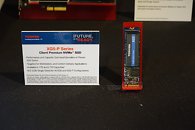Saturday, January 13th 2018

Toshiba's Not-so-flashy CES Booth was Full of Flash
Toshiba throughout 2017 made big moves in the flash storage industry, particularly its bitter falling out with WD/SanDisk. The company today is more innovative than ever. Its 2018 International CES booth had a mix of products by the original Toshiba digital storage products division, and its client-focused, US-based, former OCZ division. The star-attraction isn't some big PCIe add-on card SSD that can push a dozen terabytes per second; but the modest RC100 M.2 NVMe drive. Drives like it could make NVMe storage affordable for upper-mainstream gaming PC builders throughout 2018.
The RC100 has been exhaustively detailed in one of our older articles. It's an M.2-2242 drive with PCIe gen 3.0 x2 interface, and more than triple the transfer rates of the fastest SATA SSD you can find. This drive will be gulped down by both the DIY and OEM markets. Next up, is the TR200 entry-level SATA SSD launched last October, targeted at those still clinging onto HDDs or first-time builders. It features Toshiba's 64-layer TLC NAND flash to achieve some of the lowest price-per-gigabyte ratios.Moving on, we find the new XG5-P high-end M.2 NVMe SSDs, in its more affordable 1 TB flavor. It was launched with a sole 2 TB model last November. The drive combines 64-layer 3D NAND flash memory with Toshiba's in-house designed TC58NCP090GSD controller, and offers increased write performance over the XG5 series, and support for the slightly newer NVMe 1.2.1 revision. It reads at speeds of up to 3000 MB/s, with up to 2200 MB/s writes (compared to up to 2100 MB/s on the XG5). Its 4K random access performance is rated at 320,000/265,000 IOPS (reads/writes).
BiCS Flash Puts on a Suit: At the 2018 CES, Toshiba showed off its first enterprise-grade SSDs that implement its 64-layer 3D TLC NAND flash memory, dubbed BiCS Flash, beginning with the CM5 and PM5 SSDs in the 9.5 mm-thick 2.5-inch form-factor. The CM5 is faster, implementing either U.2 in its 2.5-inch form-factor, or PCI-Express 3.0 x4 in its add-on card form-factor. The PM5, implements SAS 12 Gb/s. There's also the HK4-series enterprise SATA SSD, targeted at datacenters that could use the low response times of SSDs, but don't necessarily need a lot of data bandwidth. These drives feature SATA 6 Gb/s interface, and come in capacities of 960 GB and 1920 GB.Lastly, there's the BG-series micro SSD for embedded applications. The drive is a single-package SATA SSD. A multi-chip module holds 3D TLC NAND flash and controller into a single package, with wireouts for just power and SATA. This is slightly different in function to eMMC SSDs. Embedded systems manufacturers can either buy them in reels of just the chip, and embed them directly on their product PCBs, or buy them in tiny M.2 SATA drives. It comes in capacities of up to 512 GB.
The RC100 has been exhaustively detailed in one of our older articles. It's an M.2-2242 drive with PCIe gen 3.0 x2 interface, and more than triple the transfer rates of the fastest SATA SSD you can find. This drive will be gulped down by both the DIY and OEM markets. Next up, is the TR200 entry-level SATA SSD launched last October, targeted at those still clinging onto HDDs or first-time builders. It features Toshiba's 64-layer TLC NAND flash to achieve some of the lowest price-per-gigabyte ratios.Moving on, we find the new XG5-P high-end M.2 NVMe SSDs, in its more affordable 1 TB flavor. It was launched with a sole 2 TB model last November. The drive combines 64-layer 3D NAND flash memory with Toshiba's in-house designed TC58NCP090GSD controller, and offers increased write performance over the XG5 series, and support for the slightly newer NVMe 1.2.1 revision. It reads at speeds of up to 3000 MB/s, with up to 2200 MB/s writes (compared to up to 2100 MB/s on the XG5). Its 4K random access performance is rated at 320,000/265,000 IOPS (reads/writes).
BiCS Flash Puts on a Suit: At the 2018 CES, Toshiba showed off its first enterprise-grade SSDs that implement its 64-layer 3D TLC NAND flash memory, dubbed BiCS Flash, beginning with the CM5 and PM5 SSDs in the 9.5 mm-thick 2.5-inch form-factor. The CM5 is faster, implementing either U.2 in its 2.5-inch form-factor, or PCI-Express 3.0 x4 in its add-on card form-factor. The PM5, implements SAS 12 Gb/s. There's also the HK4-series enterprise SATA SSD, targeted at datacenters that could use the low response times of SSDs, but don't necessarily need a lot of data bandwidth. These drives feature SATA 6 Gb/s interface, and come in capacities of 960 GB and 1920 GB.Lastly, there's the BG-series micro SSD for embedded applications. The drive is a single-package SATA SSD. A multi-chip module holds 3D TLC NAND flash and controller into a single package, with wireouts for just power and SATA. This is slightly different in function to eMMC SSDs. Embedded systems manufacturers can either buy them in reels of just the chip, and embed them directly on their product PCBs, or buy them in tiny M.2 SATA drives. It comes in capacities of up to 512 GB.









9 Comments on Toshiba's Not-so-flashy CES Booth was Full of Flash
Even there's performance NVMe drive that's branded as OCZ. And mainstream one branded with Toshiba.
So, in OCZ case it's not a total takeover. Yet (kinda merging)
It's different from what Seagate did (killed) with Samsung's Hard Disk Drive Business.
...Smiled.
I though toshiba where close to going under....
I work for SGI since 2008 :(